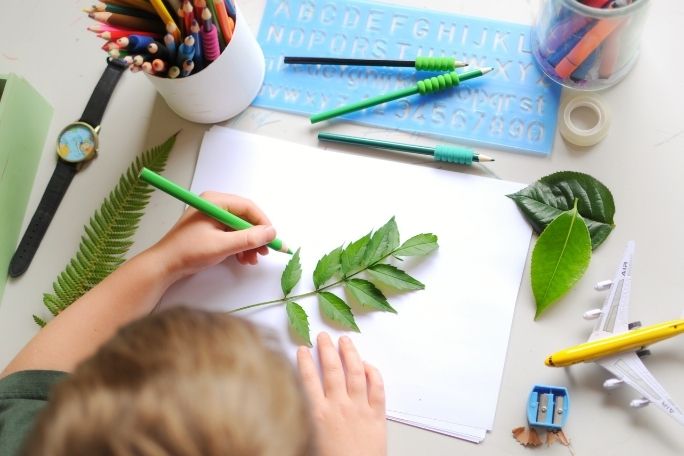Lesson summary
Students explore the plants in the school yard, focusing on leaf variation. They begin by creating a word cloud of terms relating to plants, and think about why we need plants. Students are then asked to observe a range of different plant materials (such as bark, twigs, seeds, etc.) and then focus specifically on leaves and the variety of leaf veins (venation). They will then participate in an observational drawing activity to represent a range of different types of leaves, and finally will share their favourite drawing with the class.
Learning intentions:
Students will...
- understand that there are a great variety of plants and leaves
- understand why plants are important
- practice and develop observational drawing skills and are able to select the techniques that are best suited to different subjects
Success criteria:
Students can...
- name the parts of a plant
- describe what leaf venation is
- give a reason for why plants are important
- use a range of colour pencil or pen drawing and colouring techniques
- use the observation technique to draw a picture of a plant
Lesson guides and printables
Lesson details
Curriculum mapping
Australian curriculum content descriptions:
Year 3 & 4 Visual Arts:
- Use materials, techniques and processes to explore visual conventions when making artworks (ACAVAM111)
- Present artworks and describe how they have used visual conventions to represent their ideas (ACAVAM112)
Year 3 Science:
- Living things can be grouped on the basis of observable features and can be distinguished from non-living things (ACSSU044)
Year 4 Science:
- Living things depend on each other and the environment to survive (ACSSU073)
Syllabus outcomes: VAS2.1, VAS2.2, ST2-10LW, ST2-11LW.
General capabilities: Critical and creative thinking.
Cross-curriculum priority: Sustainability OI.2.
Relevant parts of Year 3 & 4 Visual Arts achievement standards: Students discuss how they and others organise the elements and processes in artworks. They plan and make artworks that communicate ideas.
Relevant parts of Year 3 Science achievement standards: Students group living things based on observable features and distinguish them from non-living things.
Relevant parts of Year 4 Science achievement standards: Students describe relationships that assist the survival of living things.
Unit of work: Creative Sustainability – Year 3 & 4.
Time required: 60 mins.
Level of teacher scaffolding: Medium – facilitate discussions, lead students in game and outdoor observation, oversee cartoon creation.
Resources required
- Student Worksheets – one copy per student
- Device capable of presenting a video to the class
- Clipboards with paper and graphite pencils for each student
- Coloured pencils or marker pens, such as Connector pens
- Leaf Venation Factsheet
- Colouring Techniques Handout
- Parts of a Plant
- Leaf Drawing Examples.
Skills
This lesson is designed to build students’ competencies in the following skills:
- Creativity
- Critical thinking
Additional info
Faber-Castell has long understood the importance of creativity to all people, especially to young people. It is also continuously searching for environmentally friendly processes and high-quality materials to enhance children’s creative experience throughout every development phase. For more information about Faber-Castell, click here.


Welcome back!
Don't have an account yet?
Log in with:
By signing up to Cool.org you consent and agree to Cool's privacy policy to
store, manage and process your personal information. To read more, please see
our privacy policy here(Opens in new tab).
Create your free Cool.org account.
Many of our resources are free, with an option to upgrade to Cool+ for premium content.
Already have an account?
Sign up with:
By signing up to Cool.org you consent and agree to Cool's privacy policy to
store, manage and process your personal information. To read more, please see
our privacy policy here(Opens in new tab).